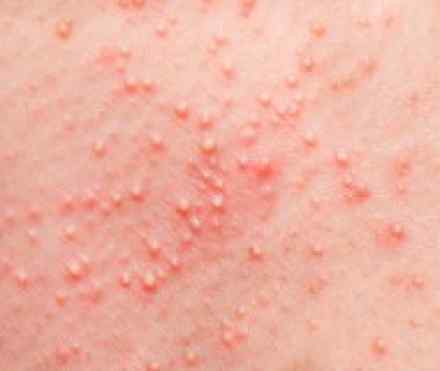
What is it?
- Contact dermatitis is an inflammation of the skin that results from direct contact with certain substances, such as soap, cosmetics, jewelry or weeds, including poison ivy or poison oak. The resulting red, itchy rash isn't contagious or life-threatening, but it can be very uncomfortable.
- Successful contact dermatitis treatment consists primarily of identifying what's causing the inflammation. Then, if you can avoid the offending agent, the rash usually resolves in two to four weeks. Self-care measures, such as wet compresses and anti-itch creams, can help soothe your skin and reduce inflammation.
Symptoms
Signs and symptoms of contact dermatitis include:
- Red rash or bumps
- Itching, which may be severe
- Dry, red patches, which may resemble a burn
- Blisters and draining fluid from the involved skin in severe cases
- Skin rash limited to the exposed area
- Pain or tenderness
In contact dermatitis, only the areas of skin exposed to the offending substances react. The area with the greatest exposure reacts most severely.
Based on the cause, contact dermatitis falls into two categories.
- Irritant contact dermatitis. This type of dermatitis is more common and results from repeated contact with a substance, such as soap, cosmetics or skin products, including deodorant, that irritates the skin. The exposure produces red, dry itchy patches usually on the hands, fingers and face. Some substances, such as bleach or strong acids, can cause irritant contact dermatitis after just one exposure. These substances typically remove oil and the protective barriers from the skin.
- Allergic contact dermatitis. This type of dermatitis is caused by a reaction to substances called allergens. The resulting reaction is your body's response to the sensitive agent. Allergic contact dermatitis produces a red rash, bumps and sometimes blisters when severe. Common allergens include rubber, metals such as nickel, costume jewelry, perfume, cosmetics, hair dyes and weeds, including poison ivy. It may take several years for an allergy to develop. Once an allergy has developed to a specific substance, however, it remains for life. Exposure to even a small amount of the allergen will reliably result in skin eruption.
Causes
The cause of contact dermatitis is direct contact with one of many irritants or allergens. These include:
- Strong detergents or soaps
- Skin cleaning products
- Cosmetics or makeup
- Deodorant
- Clothing or shoes
- Household cleaning products
- Formaldehyde and other chemicals
- Rubber or latex
- Metals, such as nickel
- Jewelry
- Perfume or fragrances
- Weeds and plants, such as poison ivy or poison oak
- Medicinal lotions, such as antihistamines, antibiotics or antiseptics
Some substances are both allergens and irritants. Examples include ingredients in soaps, detergents and some cosmetics.
It takes a greater exposure to an irritant over a longer time to cause dermatitis than it takes for an allergen. If you're sensitized to an allergen, just brief exposure to a small amount can cause contact dermatitis. If re-exposure to a substance always results in dermatitis, then this substance is more likely an allergen than an irritant. The allergen might be something that you had been in contact with for years without trouble until now. Once an allergy has developed to a specific substance, however, it remains for life.
Some substances cause dermatitis only when they contact skin exposed to sunlight (photocontact dermatitis). Typical examples include shaving lotion, sunscreens, ointments containing sulfa drugs, some perfumes and coal tar products. Other causes of contact dermatitis may be airborne, such as ragweed pollen and insecticide spray.
Occupational contact dermatitis occurs when a person is exposed to allergens or irritants on the job. Frequent exposure to water, friction, chemicals, fuels, dyes, cleaning agents, industrial solvents or dust (for example, cement dust, sawdust or paper dust) can lead to contact dermatitis.
Complications
Prolonged itching and scratching may increase the intensity of the itch, possibly leading to neurodermatitis (lichen simplex chronicus). Neurodermatitis is a condition in which an area of skin that's frequently scratched becomes thick and leathery. The patches can be raw, red or darker than the rest of your skin. Persistent scratching can also lead to a bacterial skin infection and permanent scars or changes in skin color.
Diagnosis
Patch testingYour doctor may diagnose contact dermatitis after talking to you about your signs and symptoms and examining your skin. If the cause of your rash isn't apparent or if your rash recurs often, your doctor may recommend a patch test (contact delayed hypersensitivity allergy test).
During a patch test, small quantities of potential allergens are applied to small patches, which are then placed on your skin to check for a reaction. The patches remain on your skin for two days before being evaluated by your doctor. If you're allergic to a particular substance being tested, you develop a raised bump or a reaction limited to the skin just beneath the patch.
Treatments and drugs
Contact dermatitis treatment consists primarily of:
- Avoiding the irritant. This involves identifying what's causing your irritation and then avoiding it. If this is done, it may take two to four weeks for the rash and irritation to clear up.
- Topical self-care measures. In mild to moderate cases, self-care measures, such as using creams containing hydrocortisone or applying wet dressings, can help relieve redness and itching.
- Oral medications. In severe cases, oral corticosteroids and antihistamines may be necessary to reduce the inflammation and relieve the intense itching.
Lifestyle remedies
To help reduce itching and soothe inflamed skin, try these self-care measures:
- Try to identify and avoid substances that irritate your skin or that cause an allergic reaction. These can include nickel, jewelry, perfume, cleaning products and cosmetics.
- Apply an anti-itch cream or calamine lotion to the affected area. A nonprescription hydrocortisone cream, containing at least 1 percent hydrocortisone, can temporarily relieve the itch. A nonprescription oral antihistamine, such as diphenhydramine (Benadryl, others), may be helpful if itching is severe.
- Avoid scratching whenever possible. Cover the itchy area if you can't keep from scratching it. Trim nails and wear gloves at night.
- Apply cool, wet compresses. Covering the affected area with bandages and dressings can help protect the skin and prevent scratching.
- Take a comfortably cool bath. Sprinkle the bath water with baking soda, uncooked oatmeal or colloidal oatmeal — a finely ground oatmeal that is made for the bathtub (Aveeno, others).
- Wear smooth-textured cotton clothing. This will help you avoid irritation.
- Choose mild soaps without dyes or perfumes. Be sure to rinse the soap completely off your body. And after washing, apply a moisturizer to protect your skin.
Prevention
Preventing contact dermatitis means avoiding coming into contact with those substances such as poison ivy or harsh soaps that may cause it. Prevention strategies include:
- Rinse your skin with water and use a mild soap if you come in contact with a substance. Prompt washing can remove many of the irritants or allergens from your skin. Be sure to rinse the soap completely off your body.
- Wear cotton or plastic gloves when doing housework to avoid contact with cleaners or solutions.
- If on the job, wear protective clothing or gloves to shield your skin against harmful agents.
- Apply a barrier cream or gel to your skin to provide a protective layer. Also, use a moisturizer to restore the outermost layer of skin and to prevent the evaporation of moisture.
- Use a mild, unscented laundry detergent when washing clothes, towels and bedding. Try using the extra rinse cycle on your washing machine.
References:
http://acaai.org/allergies/types/skin-allergies/contact-dermatitis
http://www.healthline.com/health/contact-dermatitis
http://www.nhs.uk/Conditions/eczema-(contact-dermatitis)/Pages/treatment.aspx
https://en.wikipedia.org/wiki/Contact_dermatitis
https://www.aad.org/public/diseases/eczema/contact-dermatitis
https://www.nlm.nih.gov/medlineplus/ency/article/000869.htm



